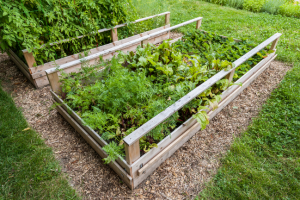Turn your backyard into the farm of your dreams with raised garden beds!
Also called “garden boxes,” raised gardens are great for growing small rows of vegetables and flowers right in one’s backyard. Because they are customizable depending on gardening desires, they can be made to suit any size of land. And, since they are not permanent, when the home is sold, if the new owners don’t want to keep the garden bed up, they are easy to remove.
 Raised beds have numerous benefits for homeowners such as:
Raised beds have numerous benefits for homeowners such as:
- They reduce pathway weeds.
- They prevent soil compaction.
- They provide good drainage.
- The sides of the beds keep soil from being eroded or washed away.
- They offer ease of accessibility to reach each plant.
- They are aesthetically pleasing.
How to Enhance Your Backyard with a Raised Garden Bed
It’s relatively easy to build your own garden bed and can even be completed in one weekend, especially when using a kit from a home improvement store.
Materials such as corrugated metal and cinder blocks have been used, but wood is the most highly recommended. Cedar wood is the top choice because it is naturally rot-resistant. You can expect a well-constructed cedar bed to last roughly 10 years.
The height of your bed can be up to 36 inches with the most common height being 11 inches (the height of two stacked boards). Keep in mind that the higher you build, the more soil you will need and the more weight will bow your sides. For this reason, cross supports are recommended for beds taller than 18 inches and/or longer than 6 feet.
A 4-foot-wide bed is the most common because it’s easy to reach the center of the bed from either side. By keeping the width narrow, you avoid having to step on the bed and compress the soil. The bed can be any length, with cross supports at every four to six feet along the length of the bed to prevent bowing.
Soil depth should be considered for the roots of the vegetables you are planting. Depending on the soil conditions in your yard, you may want to build the sides of your bed higher for crops that need more root space.
Tips for a Thriving Garden
- Build your beds to lay facing south on the horizontal.
- Turn your ground before building on it.
- Clear any roots.
- Lay hardware cloth if you have burrowing pests.
- Spread soil evenly.
- Mulched pathways between beds should be wide enough for a wheelbarrow.
Well-built and maintained garden beds are aesthetically pleasing and can even attract potential buyers. Whether in full flourish or between seasons, cleanly tilled and maintained garden beds are attractive all year long.










